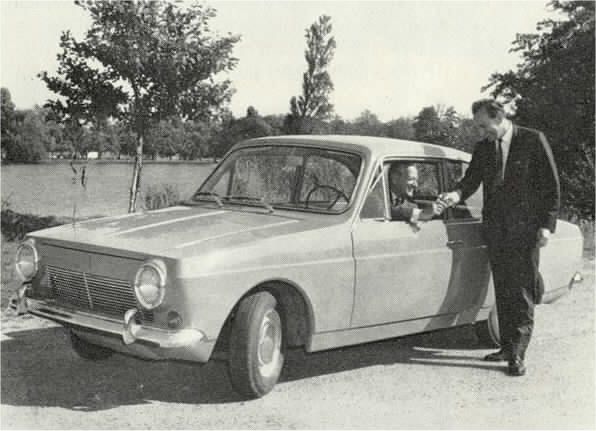In the mid-1960s, Turkey stood at the threshold of a transformative industrial leap. The streets of Istanbul buzzed with imported vehicles, while local manufacturing remained an unfulfilled dream. This scenario was about to change dramatically with the arrival of a groundbreaking project.
The development of the Anadol FW5 marked Turkey’s bold entry into automotive manufacturing. This wasn’t just about creating another car — it represented the culmination of national aspirations and technical innovation, setting the stage for a new era in Turkish industrial history.
Birth of a National Icon
The journey of the Anadol FW5 began with a strategic partnership between Turkish company Otosan and British manufacturer Reliant. The collaboration aimed to create not just a vehicle, but a symbol of Turkish industrial capability. The project moved from drawing board to reality with remarkable speed and precision.
December 1965 marked a pivotal moment when the first prototype embarked on an epic 63-hour journey to Istanbul. This wasn’t merely a delivery — it was a testament to the vehicle’s reliability and a preview of Turkish automotive ambitions.
“The Anadol FW5 wasn’t just another car launch — it represented Turkey’s industrial coming of age. Its arrival in Istanbul was like watching history unfold on four wheels.” — James Henderson, Classic Car Historian
The name “Anadol” itself emerged from a nationwide contest, reflecting the deep connection between the vehicle and national identity. This wasn’t just clever marketing — it was about creating a brand that resonated with Turkish pride and aspirations.
Historical Reference!
The December 25, 1965 government inspection of the Anadol prototype wasn't just a technical assessment — it was a crucial moment that would determine Turkey's automotive future. Officials meticulously examined every aspect of the vehicle, understanding its potential impact on national industry.
Engineering Innovation
The Anadol FW5’s technical specifications revealed a thoughtful blend of proven technology and innovative solutions. At its heart beat a robust 1.2-liter Ford four-cylinder engine, chosen for its reliability and established service network.
The decision to use a fiberglass body was revolutionary for its time. This choice wasn’t just about weight savings — it represented a sophisticated approach to manufacturing that balanced performance with practicality.
Key technical specifications that set the FW5 apart:
- advanced fiberglass body construction techniques;
- reliable Ford-sourced powertrain components;
- Lucas 12V electrical system for consistent performance;
- compact yet practical dimensions: 429cm × 160cm × 145cm;
- efficient power-to-weight ratio for its era.
The engineering choices reflected a deep understanding of both technical requirements and market realities.
“Examining the FW5’s construction today, you can appreciate the forward-thinking approach. The fiberglass body was ahead of its time, offering benefits we’re only fully appreciating now.” — Dr. Sarah Chen, Automotive Engineering Professor
Production and Legacy
The official production launch on December 19, 1966, marked the beginning of Turkey’s automotive manufacturing era. The event represented more than just the start of production — it symbolized Turkey’s entry into an exclusive club of automotive-producing nations.
Marketing efforts extended beyond Turkish borders, with sophisticated brochures targeting the UK market. These materials positioned the Anadol alongside established names like Reliant and Scimitar, demonstrating international ambitions.
Fact!
By 2020, several Anadol FW5s remained roadworthy, celebrating their 55th anniversary. This longevity speaks volumes about the vehicle's build quality and historical significance.
The Rahmi M. Koç Museum in Istanbul now proudly displays the original FW5 prototype, preserving this crucial piece of automotive history for future generations.
Modern-Day Impact
Today’s surviving Anadol FW5s command respect not just as vintage vehicles, but as pioneers of an industry. Each preserved example tells a story of Turkish innovation and determination.
Collectors and enthusiasts maintain these vehicles with remarkable dedication, understanding their significance beyond mere transportation. The FW5’s influence extends into contemporary Turkish automotive development.
Important!
The Anadol FW5's success paved the way for Turkey's current position as a significant automotive manufacturer, producing vehicles for global markets.
A Legacy That Drives Forward
The Anadol FW5’s story transcends typical automotive narratives. It represents a nation’s determination to transform itself from a market for imported vehicles into a producer of its own.
Looking at today’s thriving Turkish automotive sector, we can trace its roots back to that crucial moment in 1965 when the FW5 prototype first arrived in Istanbul.
Pros & Cons
| Advantages | Disadvantages |
|---|---|
| Pioneering fiberglass body construction offering durability and innovation | Limited power output from the 1.2L engine compared to contemporary vehicles |
| Historical significance as Turkey’s first domestically produced car | Restricted availability of replacement parts in modern times |
| Robust Ford-sourced powertrain ensuring reliability | Limited production numbers affecting collectibility |
| Lightweight construction improving efficiency | Initial market skepticism about fiberglass construction |
| Cultural importance in Turkish industrial development | Limited international market presence |
| Excellent preservation rate for a 1960s vehicle | Higher maintenance requirements due to unique construction |
| Strong collector value and historical importance | Specialized knowledge required for restoration |
The Anadol FW5 stands as more than just Turkey’s first domestically produced car — it represents a pivotal moment in industrial history. While it may not compete with modern vehicles in terms of performance or comfort, its historical significance and innovative construction make it an invaluable piece of automotive heritage. The successful blend of international expertise with local ambition created a vehicle that continues to inspire pride and admiration, establishing a foundation for Turkey’s modern automotive industry.

